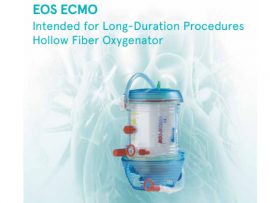Abstract OBJECTIVES Extracorporeal membrane oxygenation (ECMO) can act as a bridge to recovery in both pre- and postoperative patients with transposition of the great arteries (TGA). However, literature on its..
Read MoreAbstract Background Venoarterial extracorporeal membrane oxygenation (VA ECMO) is a critical therapeutic intervention that is commonly used in the management of paediatric patients with congenital heart disease (CHD). This procedure..
Read MoreAbstract Background Casualties of military conflicts suffer a multitude of injuries, and recent research has documented a significant number develop acute respiratory distress syndrome (ARDS). The present study undertakes a..
Read MoreAbstract OBJECTIVES The study’s aim was to investigate the outcomes and risk factors for mortality in patients undergoing surgery for acute type A aortic dissection receiving concomitant venoarterial extracorporeal membrane..
Read MoreAbstract In massive pulmonary embolism (PE), endovascular therapies and extracorporeal membrane oxygenation (ECMO) are increasingly utilised. However, the impact of combining endovascular therapies with ECMO on shock resolution and clinical recovery remains..
Read MoreAbstract Background Pericardiectomy is the curative treatment for constrictive pericarditis, yet postoperative low cardiac output syndrome (LCOS) may occur. The application of venoarterial extracorporeal membrane oxygenation (VA-ECMO) in post-pericardiectomy refractory..
Read MoreAbstract We read with great interest the recent study by Stadlbauer et al. [1] published in Intensive Care Medicine, which evaluates the impact of reperfusion therapy including systemic thrombolysis (SYS), surgical..
Read MoreAbstract Cannula-associated deep vein thrombosis (CaDVT) following decannulation from extracorporeal life support (ECLS) is a commonly reported complication with several associated risk factors. This study investigated the incidence and risk..
Read MoreAbstract Extracorporeal membrane oxygenation (ECMO), an advanced life support method, was developed to treat severe cardiac and pulmonary failure in critically ill patients. ECMO was previously used to treat ARDS,..
Read MoreAbstract Bleeding is a common complication of extracorporeal membrane oxygenation (ECMO), is multifactorial, and results in significant morbidity and mortality. Pulmonary hemorrhage represents a serious adverse event in pediatric patients..
Read MoreAbstract Aims The role of extracorporeal membrane oxygenation (ECMO) remains ill defined in pulmonary embolism (PE). We investigated outcomes in patients with high-risk PE undergoing ECMO according to initial therapeutic..
Read MoreAbstract Extracorporeal carbon dioxide removal (ECCO2R) is an emerging technique designed to reduce carbon dioxide (CO2) levels in venous blood while enabling lung-protective ventilation or alleviating the work of breathing...
Read MoreAbstract Rapid hemodynamic stabilization and restoration of pulmonary perfusion are the cornerstones of treatment for high-risk pulmonary embolism (PE). While all current guidelines recommend systemic thrombolysis (SYS) as the first-line..
Read MoreAbstract Extracorporeal life support (ECLS) has become increasingly common in the United States to manage refractory cardiopulmonary failure and has been used in complex populations including pregnant women. Application of..
Read MoreAbstract Background Acute respiratory distress syndrome (ARDS) is a severe lung condition characterized by diffuse alveolar damage and hypoxemia. Venovenous extracorporeal membrane oxygenation (vv-ECMO) supports gas exchange and reduces ventilator-induced..
Read MoreAbstract Background The optimal pulmonary revascularisation strategy in high-risk pulmonary embolism (PE) requiring implantation of extracorporeal membrane oxygenation (ECMO) remains controversial. Methods We conducted a systematic review and meta-analysis of..
Read MoreAbstract Aim To compare the long-term Health-Related Quality of Life (HRQoL) between patients receiving extracorporeal cardiopulmonary resuscitation (ECPR) and conventional cardiopulmonary resuscitation (CCPR) for out-of-hospital cardiac arrest (OHCA). Methods and..
Read MoreAbstract The use of venoarterial extracorporeal membrane oxygenation (VA-ECMO) for temporary mechanical circulatory support in various clinical scenarios has been increasing consistently, despite the lack of sufficient evidence regarding its..
Read MoreAbstract Background: High‑risk acute pulmonary embolism (PE) is a life‑threatening condition necessitating hemody‑namic stabilization and rapid restoration of pulmonary perfusion. In this context, evidence regarding the benefit ofadvanced circulatory support..
Read MoreAbstract The impact of race on extracorporeal life support (ECLS) availability, morbidity, and mortality remains poorly defined. We sought to define the impact of race/ethnicity, sex, and location on ECLS..
Read MoreAbstract Background: We used machine learning models incorporating rich electronic medical record (EMR) data to predict neurological outcomes after venoarterial extracorporeal membrane oxygenation (VA‑ECMO). Methods: This was a retrospective..
Read MoreAbstract Background The use of extracorporeal membrane oxygenation (ECMO) has expanded and is now widely applied to perioperative care in lung transplant. Respiratory failure after lung transplant is a clinical..
Read MoreAbstract Background Extracorporeal membrane oxygenation (ECMO) serves as a critical intervention for patients with severe cardiac and pulmonary dysfunction. Given the high rates of mortality and morbidity, as well as..
Read MoreAbstract Background: Venoarterial extracorporeal membrane oxygenation (VA-ECMO) is increasingly used to treat cardiogenic shock. However, VA-ECMO might hamper myocardial recovery. The Impella unloads the left ventricle. This study aimed to..
Read MoreAbstract This report presents a case series that introduces differential venous drainage (DVD) as an underrated complication arising from the hemodynamic impact of the extracorporeal life support (ECLS) circuit on..
Read MoreAbstract Introduction: The use of extracorporeal membrane oxygenation (ECMO) for cardiopulmonary failure is increasing. ECMO transport teams are needed to expand patient access. Our goal was to design and implement a..
Read MoreAbstract Background/Objectives: Secure large-bore cannula insertion is critical for effective extracorporeal membrane oxygenation (ECMO), as inadequate fixation can lead to complications such as infection, dislodgment, and life-threatening events. With inconsistent..
Read MoreAbstract Electrocardiogram (ECG)—synchronized pulsatile veno-arterial extracorporeal membrane oxygenation (V-A ECMO) is a recent development in extracorporeal therapy for patients with severe cardiogenic shock. Although preclinical studies have shown benefits of..
Read MoreAbstract Although extracorporeal membrane oxygenation (ECMO) systems have been used to provide temporary support for patients with severe respiratory or cardiac failure, they are often bedridden, in part because of..
Read MoreAbstract Background Bleeding is a common and sometimes fatal complication of venovenous extracorporeal membrane oxygenation (ECMO). Whether lowering the intensity of anticoagulation during venovenous ECMO is safe or effective is..
Read More















